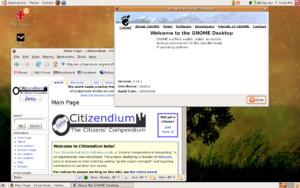Linux (operating system)
| Linux |

|
| The GNOME desktop on Ubuntu Linux 6.10 |
| Website: http://www.linux.org (unofficial) |
| Developer: The Open Source community |
| OS family: Unix-like |
| Source model: Open source |
| Supported platforms: x86, x86-64, ia64, DEC Alpha, Motorola 68k, SUN Sparc, ARM, PowerPC |
| Kernel type: Modular monolithic |
| Default user interface (most distros): GUI |
| License: GNU General Public License |
| Working state: Current |

Linux is, in its most general sense, open source operating system. It is Unix-like in the sense that the files are organized in a hierarchal file system and the average user is distinguished from the administrative accounts by an implementation of a very strict, yet capable set of permissions; thus, it is often considered to be a very secure system.
History
Linux was started in 1991 by a Finnish college student named Linus Torvalds. At the time, the majority of Unix systems were very expensive. The only affordable workstation environment was a proprietary system called Minix. Although the source code was included with this system, the license fee was still a bit pricey, and it was not as good as the systems the workstations in the universities were running.
The name
Originally, Torvalds had intended to call the system Freax, for Free, Freaks, and Unix. One of his colleagues did not like this name, however, so he named the system's FTP directory Linux in honor of its creator, with an x to denote that it is Unix-like.
GNU/Linux controversy
By strict definition, it is rarely seen by the user, because its job is to be a layer between the user environment and the hardware.